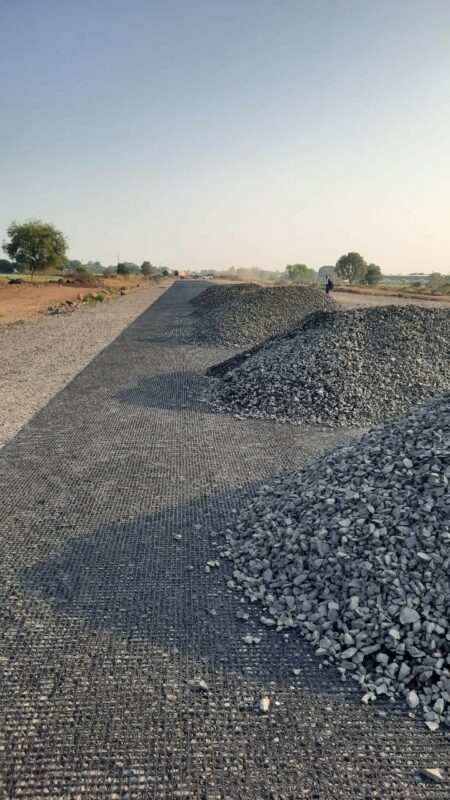Aggregates
What are aggregates?

Aggregates are granular materials such as sand, gravel, crushed stone, crushed hydraulic cement concrete, or air-cooled iron blast-furnace slag. These materials are combined with hydraulic cement to produce concrete or mortar. Aggregates are classified into two groups based on size: coarse aggregates (material retained on the 4.75-mm (No. 4) sieve) and fine aggregates (material passing the 4.75-mm (No. 4) sieve). Aggregates are the most mined materials in the world and are a key component of concrete and asphalt, enhancing their strength. They are widely used in drainage applications such as foundation and French drains, septic drain fields, retaining wall drains, and roadside edge drains, and are also used as base material under foundations, roads, and railroads.
While most aggregates require a binding agent, some self-binding types do not. In Europe, aggregate sizes are specified as d/D, where ‘d’ represents the smallest and ‘D’ the largest square mesh size through which particles can pass. Application-specific preferred sizings are covered in European Standard EN 13043 for road construction, EN 13383 for larger armour stone, EN 12620 for concrete aggregate, EN 13242 for base layers of road construction, and EN 13450 for railway ballast. The American Society for Testing and Materials publishes an exhaustive listing of specifications including ASTM D 692 and which, by their individual design, are suitable for specific construction purposes. These products include specific types of coarse and fine aggregate designed for such uses as additives to asphalt and as well as other construction uses. State transportation departments further refine aggregate material specifications in order to tailor aggregate use to specific construction needs. Sources for these basic materials can be grouped into three main areas: mining of mineral aggregate deposits, including sand, gravel, and stone; use of waste slag from the manufacture of iron and steel; and recycling of concrete, which is itself chiefly manufactured from mineral aggregates.
What are the different types of aggregates?
There are several types of aggregates used in construction, including:
Gravel : Gravel is created when stones are eroded over long periods in water or through sedimentation. These processes break them into smaller pieces naturally over time. Gravel formed through erosion is much smoother than aggregates formed through crushing or sedimentation. Rocks like limestone and sandstone are mined in quarries and then transported for processing and fed through crushing equipment, which breaks them into smaller bits. Crushed rocks are more jagged than gravel, making them more durable. Crushed stone is great for making foundations and roads due to its superior durability.
Sand : Sand is a small, naturally occurring form of quartz. There are also manufactured sands, known as artificial sands, created when stone or concrete is crushed into extremely fine bits. Sand is broken down into two different types: fine and coarse. Fine sand is used as a filler and bulking material in construction due to its small size and ability to be packed tightly. This allows it to fill in the empty spaces other construction aggregates like gravel can’t. Coarse sand is used as a primary component in concrete mixtures.
Recycled aggregate: Recycled aggregates, obtained from reprocessed construction materials, include construction demolition waste (CDW), reclaimed asphalt (RAP), crushed glass, and spent railway ballast
Natural aggregates : Natural aggregates, or primary aggregates, are virgin materials that are typically sourced from a quarry or dredged from marine locations. The material is not subject to anything other than mechanical processing eg rock crushing. This includes crushed rock, sand and gravel.
Secondary aggregate : Secondary aggregates, like Aggneo, are by-products of industrial processes. These include manufactured slag (e.g., blast furnace and steel slag) and naturally occurring materials like china clay. This includes both manufactured slag (blast furnace, steel) and naturally occurring aggregates (china clay), depending on their source. China Clay is a virgin aggregate, the surrounding rock (such as a granite deposit) that is excavated to acquire the desired material (china clay) is the Recycled aggregate. Recycled aggregates come from reprocessed construction materials.
Examples of recycled aggregates include: – construction demolition waste (CDW) – reclaimed asphalt (otherwise known as RAP) – crushed glass – spent railway ballast. These aggregates are used in various applications, including asphalt for road construction, concrete, precast concrete including paving, bricks and blocks, drainage systems, cement, sub-bases, and even in producing items such as glass, water filtration, ceramics, pharmaceuticals, and foundries. Aggregates are produced through extraction, crushing, and screening methods to produce the sizes required for different types of construction projects and materials.
How are aggregates extracted and processed?
Aggregates are extracted and processed through a series of steps that involve various methods and heavy machinery. The extraction process typically involves quarrying, where aggregates are removed from natural sources like quarries using heavy machinery such as excavators. In some cases, aggregate extraction can also occur at building sites where broken concrete is recycled into new aggregates. Once extracted, aggregates undergo processing which includes crushing, screening, and washing. The extracted raw material is crushed using heavy machinery like crushers to break it down into smaller pieces. Screening is then done to remove oversized pieces and separate the material into different sizes based on its intended use. Washing may be necessary to remove impurities or unwanted materials from the aggregates. The final step involves sorting particles based on their characteristics to ensure they meet required specifications. Overall, the processing of aggregates involves a complex series of steps designed to produce high-quality products that meet the specific needs of the construction industry. This process is crucial as aggregates are fundamental materials used in various construction applications, including roads, buildings, and other structures.
